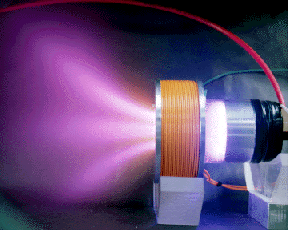Creating a
True Blue Light
 Light emitting diodes, familiarly known as LEDs, are the
electronics industry's prodigy child, one that until now has been slow to
mature. LEDs can be found everywhere -- from the dashboard of your car to the
lighted display on your stereo. Yet even though 20 billion new LEDs are
manufactured each year, their spectrum of uses has been restricted due to the
absence of the color blue.
Light emitting diodes, familiarly known as LEDs, are the
electronics industry's prodigy child, one that until now has been slow to
mature. LEDs can be found everywhere -- from the dashboard of your car to the
lighted display on your stereo. Yet even though 20 billion new LEDs are
manufactured each year, their spectrum of uses has been restricted due to the
absence of the color blue.
When red and green LEDs were developed years ago, researchers began a two-decade-long effort to create affordable blue light. Without blue light, LEDs can perform simple functions like lighting up the numbers on a clock, but when blue light is combined with green and red, LEDs can create the full spectrum of visible light. Ultimately, such a full-color light emitter could replace the cathode ray tube and the incandescent light bulb.
Japanese researchers developed a blue gallium nitride LED in 1993, but they now have
competition. LBL's Mike Rubin and Eicke Weber have teamed with Hewlett-Packard,
America's dominant LED producer. Using a different process that has several
inherent advantages, LBL is attempting to grow materials that will allow HP to
produce a bright, reliable, and affordable blue LED, and eventually a blue
semiconductor laser.
LEDs are an ideal light source. They are reliable, have long lifetimes, and are
remarkably efficient. LED-based flat
panel computer and television displays could be brighter and more energy
efficient than the current liquid crystal display devices. As a white light
source, low cost and high brightness LEDs could potentially be developed to
replace incandescent and other types of light bulbs. In addition, blue
semiconductor lasers could quadruple the amount of information that can be
recorded on current optical data storage devices such as CDs.
Like the Japanese, the LBL/HP team is focusing on gallium nitride, a semiconductor that can emit blue light. The problem with gallium-nitride based materials lies in the atomic details. To generate light, two thin-film layers, laced with precisely controlled
impurity concentrations that cause them to have opposite electrical properties,
are sandwiched together. One side has a surplus of electrons, and the other an
excess of positive charge-carriers called holes. When current is passed through
the sandwich, electrons and holes are forced into the junction between the
layers, causing them to recombine and emit a photon (light).
Though promising, the positive half of the gallium-nitride semiconductor sandwich
typically has been defective. LBL's expertise in advanced materials processing
and characterization techniques has enabled an atomic-level look not only at
how these defects occur, but also at how to eliminate them. Based upon what
they have learned, researchers are experimenting with a different fabrication
approach. They are using a nitrogen ion beam to grow more precisely structured
thin films. The source of the ion beam was developed at LBL and specially
designed to reduce the problems with structural damage and contamination.
Progress by LBL and HP, and others around the world, indicates that
decades of LED research is about to pay off.
-- Jeffery Kahn
 Light emitting diodes, familiarly known as LEDs, are the
electronics industry's prodigy child, one that until now has been slow to
mature. LEDs can be found everywhere -- from the dashboard of your car to the
lighted display on your stereo. Yet even though 20 billion new LEDs are
manufactured each year, their spectrum of uses has been restricted due to the
absence of the color blue.
Light emitting diodes, familiarly known as LEDs, are the
electronics industry's prodigy child, one that until now has been slow to
mature. LEDs can be found everywhere -- from the dashboard of your car to the
lighted display on your stereo. Yet even though 20 billion new LEDs are
manufactured each year, their spectrum of uses has been restricted due to the
absence of the color blue. 
 Return to Highlights Table of Contents
Return to Highlights Table of Contents